View in other NatureServe Network Field Guides
NatureServe
Montana
Utah
Wyoming
Idaho
Wisconsin
British Columbia
South Carolina
Yukon
California
New York
Rocky Mountain Goldenrod - Solidago multiradiata
Native Species
Global Rank:
G5
State Rank:
S4
C-value:
4
Agency Status
USFWS:
USFS:
BLM:
External Links
General Description
Plants with a branched caudex. Stems ascending, simple, 5–40 cm. Herbage sparsely villous to glabrous. Leaves basal and cauline; basal blades oblong to oblanceolate, mostly serrate, 1–7 cm long, with 1 prominent vein; basal leaf petioles broad, ciliate; cauline becoming sessile upward. Inflorescence hemispheric- to oblong-paniculate with few heads. Involucres campanulate, 5–7 mm high; phyllaries lanceolate to oblanceolate, ciliate. Rays 12 to 18; ligules 3–5 mm long. Disk flowers 10 to 35; corollas 4–6 mm long. Achenes 1–3 mm long, strigose (
Lesica et al. 2012. Manual of Montana Vascular Plants. BRIT Press. Fort Worth, TX).
Our plants are variety
scopulorum A.Gray
Species Range
Montana Range
Range Descriptions
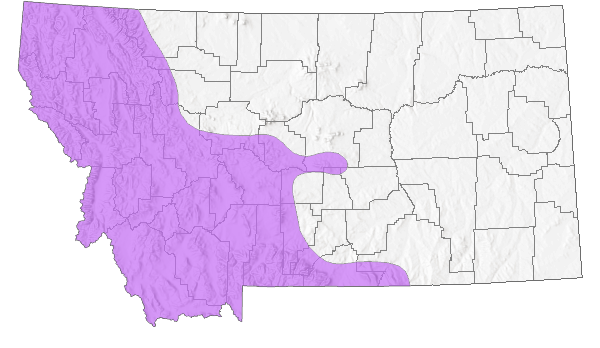
 Native
Native
Range Comments
AK to QC south to CA, AZ and NM (Lesica et al. 2012. Manual of Montana Vascular Plants. BRIT Press. Fort Worth, TX).
Observations in Montana Natural Heritage Program Database
Number of Observations: 297
(Click on the following maps and charts to see full sized version)
Map Help and Descriptions
Relative Density

Recency
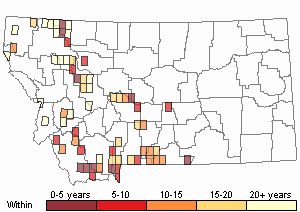
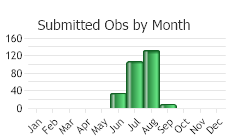
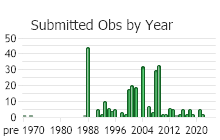
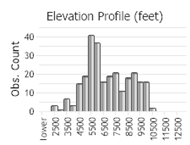 (Observations spanning multiple months or years are excluded from time charts)
(Observations spanning multiple months or years are excluded from time charts)
Habitat
Often stony soil of grasslands, turf, meadows, dry open forest, talus, fellfields; subalpine, alpine, lower along rivers (
Lesica et al. 2012. Manual of Montana Vascular Plants. BRIT Press. Fort Worth, TX).
National Vegetation Classification System Groups Associated with this Species
Ecology
POLLINATORS The following animal species have been reported as pollinators of this plant species or its genus where their geographic ranges overlap:
Bombus vagans,
Bombus appositus,
Bombus bifarius,
Bombus borealis,
Bombus fervidus,
Bombus flavifrons,
Bombus huntii,
Bombus melanopygus,
Bombus mixtus,
Bombus nevadensis,
Bombus rufocinctus,
Bombus ternarius,
Bombus terricola,
Bombus sitkensis,
Bombus occidentalis,
Bombus pensylvanicus,
Bombus bimaculatus,
Bombus griseocollis,
Bombus impatiens,
Bombus insularis,
Bombus suckleyi,
Bombus bohemicus,
Bombus flavidus, and
Bombus kirbiellus (Plath 1934, Heinrich 1976, Thorp et al. 1983, Johnson 1986, Shaw and Taylor 1986, Mayer et al. 2000, Colla and Dumesh 2010, Colla et al. 2011, Koch et al. 2012, Williams et al. 2014, Tripoldi and Szalanski 2015).
Stewardship Responsibility
References
- Literature Cited AboveLegend:
 View Online Publication
View Online Publication Colla, S., L. Richardson, and P. Williams. 2011. Bumble bees of the eastern United States. Washington, DC: USDA Forest Service, Pollinator Partnership. 103 p.
Colla, S., L. Richardson, and P. Williams. 2011. Bumble bees of the eastern United States. Washington, DC: USDA Forest Service, Pollinator Partnership. 103 p. Colla, S.R. and S. Dumesh. 2010. The bumble bees of southern Ontario: notes on natural history and distribution. Journal of the Entomological Society of Ontario 141:39-68.
Colla, S.R. and S. Dumesh. 2010. The bumble bees of southern Ontario: notes on natural history and distribution. Journal of the Entomological Society of Ontario 141:39-68. Johnson, R.A. 1986. Intraspecific resource partitioning in the bumble bees Bombus ternarius and B. pennsylvanicus. Ecology 67:133-138.
Johnson, R.A. 1986. Intraspecific resource partitioning in the bumble bees Bombus ternarius and B. pennsylvanicus. Ecology 67:133-138. Koch, J., J. Strange, and P. Williams. 2012. Bumble bees of the western United States. Washington, DC: USDA Forest Service, Pollinator Partnership. 143 p.
Koch, J., J. Strange, and P. Williams. 2012. Bumble bees of the western United States. Washington, DC: USDA Forest Service, Pollinator Partnership. 143 p. Lesica, P., M.T. Lavin, and P.F. Stickney. 2012. Manual of Montana Vascular Plants. Fort Worth, TX: BRIT Press. viii + 771 p.
Lesica, P., M.T. Lavin, and P.F. Stickney. 2012. Manual of Montana Vascular Plants. Fort Worth, TX: BRIT Press. viii + 771 p. Mayer, D.F., E.R. Miliczky, B.F. Finnigan, and C.A. Johnson. 2000. The bee fauna (Hymenoptera: Apoidea) of southeastern Washington. Journal of the Entomological Society of British Columbia 97: 25-31.
Mayer, D.F., E.R. Miliczky, B.F. Finnigan, and C.A. Johnson. 2000. The bee fauna (Hymenoptera: Apoidea) of southeastern Washington. Journal of the Entomological Society of British Columbia 97: 25-31. Plath, O.E. 1934. Bumblebees and their ways. New York, NY: Macmillan Company. 201 p.
Plath, O.E. 1934. Bumblebees and their ways. New York, NY: Macmillan Company. 201 p. Shaw, D.C. and R.J. Taylor.1986. Pollination ecology of an alpine fell-field community in the North Cascades. Northwest Science 60:21-31.
Shaw, D.C. and R.J. Taylor.1986. Pollination ecology of an alpine fell-field community in the North Cascades. Northwest Science 60:21-31. Thorp, R.W., D.S. Horning, and L.L. Dunning. 1983. Bumble bees and cuckoo bumble bees of California (Hymenoptera: Apidae). Bulletin of the California Insect Survey 23:1-79.
Thorp, R.W., D.S. Horning, and L.L. Dunning. 1983. Bumble bees and cuckoo bumble bees of California (Hymenoptera: Apidae). Bulletin of the California Insect Survey 23:1-79. Tripoldi, A.D. and A.L. Szalanski. 2015. The bumble bees (Hymenoptera: Apidae: Bombus) of Arkansas, fifty years later. Journal of Melittology 50: doi: http://dx.doi.org/10.17161/jom.v0i50.4834
Tripoldi, A.D. and A.L. Szalanski. 2015. The bumble bees (Hymenoptera: Apidae: Bombus) of Arkansas, fifty years later. Journal of Melittology 50: doi: http://dx.doi.org/10.17161/jom.v0i50.4834 Williams, P., R. Thorp, L. Richardson, and S. Colla. 2014. Bumble Bees of North America. Princeton, NJ: Princeton University Press. 208 p.
Williams, P., R. Thorp, L. Richardson, and S. Colla. 2014. Bumble Bees of North America. Princeton, NJ: Princeton University Press. 208 p.
- Additional ReferencesLegend:
 View Online Publication
View Online Publication
Do you know of a citation we're missing? Aho, Ken Andrew. 2006. Alpine and Cliff Ecosystems in the North-Central Rocky Mountains. Ph.D. Dissertation. Bozeman, Montana: Montana State University. 343 p.
Aho, Ken Andrew. 2006. Alpine and Cliff Ecosystems in the North-Central Rocky Mountains. Ph.D. Dissertation. Bozeman, Montana: Montana State University. 343 p. Ament, R.J. 1995. Pioneer Plant Communities Five Years After the 1988 Yellowstone Fires. M.Sc. Thesis. Bozeman, MT: Montana State University. 216 p.
Ament, R.J. 1995. Pioneer Plant Communities Five Years After the 1988 Yellowstone Fires. M.Sc. Thesis. Bozeman, MT: Montana State University. 216 p. Clark, D. 1991. The effect of fire on Yellowstone ecosystem seed banks. M.Sc. Thesis. Montana State University, Bozeman. 115 pp.
Clark, D. 1991. The effect of fire on Yellowstone ecosystem seed banks. M.Sc. Thesis. Montana State University, Bozeman. 115 pp. Conway, T.M. 1982. Response of understory vegetation to varied lodgepole pine (Pinus contorta) spacing intervals in Western Montana. M.Sc. Thesis. Bpzeman, MT: Montana State University. 76 p.
Conway, T.M. 1982. Response of understory vegetation to varied lodgepole pine (Pinus contorta) spacing intervals in Western Montana. M.Sc. Thesis. Bpzeman, MT: Montana State University. 76 p. Culver, D.R. 1994. Floristic analysis of the Centennial Region, Montana. M.Sc. Thesis. Montana State University, Bozeman. 199 pp.
Culver, D.R. 1994. Floristic analysis of the Centennial Region, Montana. M.Sc. Thesis. Montana State University, Bozeman. 199 pp. Forcella, F. 1977. Flora, chorology, biomass and productivity of the Pinus albicaulis-Vaccinium scoparium association. M.S. Thesis. Bozeman, MT: Montana State University. 99 pp.
Forcella, F. 1977. Flora, chorology, biomass and productivity of the Pinus albicaulis-Vaccinium scoparium association. M.S. Thesis. Bozeman, MT: Montana State University. 99 pp. Fultz, J.E. 2005. Effects of shelterwood management on flower-visiting insects and their floral resources. M.Sc. Thesis. Bozeman, MT: Montana State University. 163 p.
Fultz, J.E. 2005. Effects of shelterwood management on flower-visiting insects and their floral resources. M.Sc. Thesis. Bozeman, MT: Montana State University. 163 p. Hawkins, P.H. 1903. The alpine flora of Montana. M.Sc. Thesis, Bozeman, MT: Montana State University. 24 pp.
Hawkins, P.H. 1903. The alpine flora of Montana. M.Sc. Thesis, Bozeman, MT: Montana State University. 24 pp. Jones, W. W. 1901. Preliminary flora of Gallatin County. M.S. Thesis. Bozeman, MT: Montana State College. 78 pp.
Jones, W. W. 1901. Preliminary flora of Gallatin County. M.S. Thesis. Bozeman, MT: Montana State College. 78 pp. Joslin, G.J. 1975. Behavior and environmental selection by Elk (Cervus canadensis nelsoni) during surrmer and fall in the First and Second Yellow Mule drainages, Madison County, Montana. M.Sc. Thesis. Bozeman, Montana: Montana State University, Bozeman. 65 p.
Joslin, G.J. 1975. Behavior and environmental selection by Elk (Cervus canadensis nelsoni) during surrmer and fall in the First and Second Yellow Mule drainages, Madison County, Montana. M.Sc. Thesis. Bozeman, Montana: Montana State University, Bozeman. 65 p. Lesica, P., M.T. Lavin, and P.F. Stickney. 2022. Manual of Montana Vascular Plants, Second Edition. Fort Worth, TX: BRIT Press. viii + 779 p.
Lesica, P., M.T. Lavin, and P.F. Stickney. 2022. Manual of Montana Vascular Plants, Second Edition. Fort Worth, TX: BRIT Press. viii + 779 p. Martin, S.A. 1985. Ecology of the Rock Creek bighorn sheep herd, Beartooth Mountains, Montana. M.Sc. Thesis. Bozeman, MT: Montana State University. 152 p.
Martin, S.A. 1985. Ecology of the Rock Creek bighorn sheep herd, Beartooth Mountains, Montana. M.Sc. Thesis. Bozeman, MT: Montana State University. 152 p. Plaggemeyer, J.B. 1995. Effects of overstory thinning on lodgepole pine understories. M.Sc. Thesis. Bozeman, MT: Montana State University. 55 p.
Plaggemeyer, J.B. 1995. Effects of overstory thinning on lodgepole pine understories. M.Sc. Thesis. Bozeman, MT: Montana State University. 55 p. Saunders, J.K. Jr. 1955. Food habits and range use of the Rocky Mountain goat in the Crazy Mountains, Montana. Journal of Wildlife Management 19(4):429-437.
Saunders, J.K. Jr. 1955. Food habits and range use of the Rocky Mountain goat in the Crazy Mountains, Montana. Journal of Wildlife Management 19(4):429-437. Saunders, J.K., Jr. 1954. A two-year investigation of the food habits and range use of the Rocky Mountain goat in the Crazy Mountains, Montana. M.Sc. Thesis. Bozeman, MT: Montana State University. 22 p.
Saunders, J.K., Jr. 1954. A two-year investigation of the food habits and range use of the Rocky Mountain goat in the Crazy Mountains, Montana. M.Sc. Thesis. Bozeman, MT: Montana State University. 22 p. Seipel, T.F. 2006. Plant species diversity in the sagebrush steppe of Montana. M.Sc. Thesis. Bozeman, MT: Montana State University. 87 p.
Seipel, T.F. 2006. Plant species diversity in the sagebrush steppe of Montana. M.Sc. Thesis. Bozeman, MT: Montana State University. 87 p. Simanonok, M. 2018. Plant-pollinator network assembly after wildfire. Ph.D. Dissertation. Bozeman, MT: Montana State University. 123 p.
Simanonok, M. 2018. Plant-pollinator network assembly after wildfire. Ph.D. Dissertation. Bozeman, MT: Montana State University. 123 p. Simanonok, M.P. and L.A. Burkle. 2019. Nesting success of wood-cavity-nesting bees declines with increasing time since wildfire. Ecology and Evolution 9:12436-12445.
Simanonok, M.P. and L.A. Burkle. 2019. Nesting success of wood-cavity-nesting bees declines with increasing time since wildfire. Ecology and Evolution 9:12436-12445. Williams, K.L. 2012. Classification of the grasslands, shrublands, woodlands, forests and alpine vegetation associations of the Custer National Forest portion of the Beartooth Mountains in southcentral Montana. M.Sc. Thesis. Bozeman, MT: Montana State University. 376 p.
Williams, K.L. 2012. Classification of the grasslands, shrublands, woodlands, forests and alpine vegetation associations of the Custer National Forest portion of the Beartooth Mountains in southcentral Montana. M.Sc. Thesis. Bozeman, MT: Montana State University. 376 p. Wood, M.A. 1981. Small mammal communities after two recent fires in Yellowstone National Park. M.Sc. Thesis. Bozeman, Montana: Montana State University. 58 p.
Wood, M.A. 1981. Small mammal communities after two recent fires in Yellowstone National Park. M.Sc. Thesis. Bozeman, Montana: Montana State University. 58 p.
- Web Search Engines for Articles on "Rocky Mountain Goldenrod"





